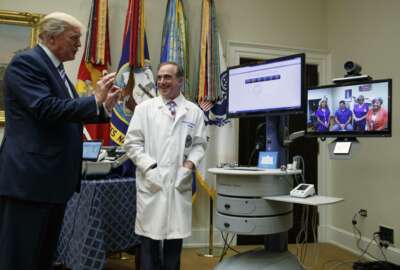Since the Veterans Affairs Department began mapping customer experience in earnest, the agency has learned a key lesson about the customers it serves: The veteran population is diverse and each veteran’s experience with the VA often differs from one another.
VA is beginning to learn more from its veterans about those experiences, based on a constant loop of feedback that it receives from its customers.
That feedback will be key as VA expands one of its largest customer service programs. VA providers in all states will soon be able to practice with the department’s telehealth services, or “anywhere to anywhere” health care. The department announced the expansion at a White House event with the president Aug. 3.
Surveys are becoming part of VA’s feedback loop. The department is beginning to collect and examine data points from those surveys to study trends in veterans’ experiences.
“We’re actually seeing really strong response rates on the surveys that are live today from veterans,” said Brian Michael, general manager for Medallia’s public sector practice, the subcontractor on VA’s customer experience contract. “They want to be heard. Many of them have things to say and have experienced things in some cases multiple times that they want fixed.”
The goal, Michael said, is to develop transactional surveys for veterans to give feedback at any key moment in their experience with VA by a phone call, email or text. From there, every VA employee will have access to a constant loop of veteran feedback specific to their job and function.
“What’s it like scheduling your appointment, [or] perhaps, going to the pharmacy or other key moments that matter? Being able to, in time, look at … what is the scheduling experience for a telehealth visit, versus a more traditional brick and mortar visit? What are our veterans telling us about these two?” Michael said.
Telehealth related surveys are still in the design phase.
Existing telehealth programs provided care to more than 700,000 veterans last year and covered at least 50 different specialties, from dentistry to dermatology. VA sees telehealth as a key component in its daily operations — and in the veteran’s experience.
“We want to make it easy,” Dr. Kevin Galpin, executive director of telehealth services for the Veterans Health Administration, told a House Veterans Affairs subcommittee during a field hearing on the topic in Traverse City, Michigan. “I want to be able to send a link to a veteran and say, ‘Hey, let’s jump on a video call, because you called in and said you have a rash and I’d like to look at it. Or, I got your X-ray back today and I want to show it to you, not just describe it to you.”
Program still evolving
The department will release a more detailed report on the barriers it sees to fully implementing the telehealth expansion. That report is currently under review at the Office of Management and Budget, Galpin said.
State licensing restrictions and provider authorizations are one of those big challenges. VA plans to issue joint regulations with the White House Office of American Innovation and the Justice Department that would allow all VA providers to administer telehealth services to veterans anywhere in the country.
“We have the authority in the VA to get us most of the way there, and that’s what the secretary and the president were talking about at their event,” Galpin said. “VA has existing authority if we put out regulations. We have always preferred a legislative approach to this. It is the best solution. Legislation could take us farther than regulations can; we can develop new authorities through that.”
If VA only relies on its own regulations, the department won’t be able to reach all veterans with its telehealth program, Galpin added.
Some veterans live across the U.S. border in Canada and drive in to a VA medical center for care. Regulations wouldn’t allow VA to treat those patients who live in another country, Galpin said.
IT funding another issue
To expand the program to the scope VA wants, Galpin said his office will need an additional $25 million in IT funding a year. The president’s fiscal 2018 budget proposed $215 million in cuts to VA IT funding next year.
Beyond the department’s IT budget itself, VA continues to run into legislative barriers when it attempts to move money from one appropriations account to another.
For example, the department bought roughly 6,000 connected tablets for veterans who don’t have their own devices to use to connect virtually with a VA provider.
“We have a clinical bucket of money and we have a technology, IT bucket of money,” Galpin said. “When I buy a tablet for a veteran, is it … IT money? Is it clinical money? Depending on the situation, it could be either, and so that confuses people.”
Copyright
© 2024 Federal News Network. All rights reserved. This website is not intended for users located within the European Economic Area.
